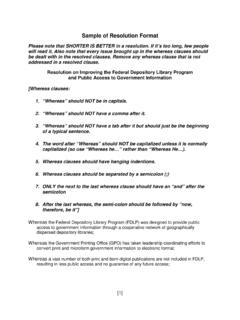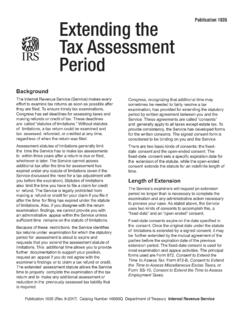Transcription of 2020 Instructions for Form 940 - IRS
1 Userid: CPMS chema: instrxLeadpct: 100%Pt. size: 10 Draft Ok to PrintAH XSL/XMLF ileid: .. tions/I940/2017/A/XML/Cycle07/source(Ini t. & Date) _____Page 1 of 15 15:55 - 16-Nov-2017 The type and rule above prints on all proofs including departmental reproduction proofs. MUST be removed before for form 940 Employer's Annual Federal Unemployment (FUTA) Tax ReturnDepartment of the TreasuryInternal Revenue ServiceSection references are to the Internal Revenue Code unless otherwise DevelopmentsFor the latest information about developments related to form 940 and its Instructions , such as legislation enacted after they were published, go to 's NewNew certification program for professional employer organizations. The Tax Increase Prevention Act of 2014 required the IRS to establish a voluntary certification program for professional employer organizations (PEOs).
2 PEOs handle various payroll administration and tax reporting responsibilities for their business clients and are typically paid a fee based on payroll costs. To become and remain certified under the certification program, certified professional employer organizations (CPEOs) must meet various requirements described in sections 3511 and 7705 and related published guidance. Certification as a CPEO may affect the employment tax liabilities of both the CPEO and its customers. A CPEO is generally treated as the employer of any individual who performs services for a customer of the CPEO and is covered by a contract described in section 7705(e)(2) between the CPEO and the customer (CPEO contract), but only for wages and other compensation paid to the individual by the CPEO.
3 For more information, visit the IRS website at wages paid to a work site employee, a CPEO is eligible for the credit for state unemployment tax paid to a state unemployment fund, whether the CPEO or a customer of the CPEO made the contribution. In addition, a CPEO is allowed the additional credit if the CPEO is permitted, under state law, to collect and remit contributions to the state unemployment fund with respect to a work site employee. For more information on the credit, see Credit for State Unemployment Tax Paid to a State Unemployment Fund, generally must file form 940 and Schedule R ( form 940), Allocation Schedule for Aggregate form 940 Filers, electronically. For more information about a CPEO s requirement to file electronically, see Rev. Proc.
4 2017-14, 2017-3 426, available at reduction state. A state that hasn't repaid money it borrowed from the federal government to pay unemployment benefits is a credit reduction state. The Department of Labor determines these states. If an employer pays wages that are subject to the unemployment tax laws of a credit reduction state, that employer must pay additional federal unemployment tax when filing its form 2017, there are credit reduction states. If you paid any wages that are subject to the unemployment compensation laws of a credit reduction state, your credit against federal unemployment tax will be reduced based on the credit reduction rate for that credit reduction state. Use Schedule A ( form 940) to figure the credit reduction. For more information, see the Schedule A ( form 940) Instructions or visit you change your business name, business ad-dress, or responsible party.
5 Notify the IRS immediately if you change your business name, business address, or responsible to the IRS office where you file your returns (using the Without a payment address under Where Do You File, later) to notify the IRS of any business name change. See Pub. 1635 to see if you need to apply for a new employer identification number (EIN).Complete and mail form 8822-B to notify the IRS of a business address or responsible party change. Don t mail form 8822-B with your form 940. For a definition of responsible party, see the form 8822-B tax deposits must be made by electronic funds transfer (EFT). You must use EFT to make all federal tax deposits. Generally, an EFT is made using the Electronic Federal Tax Payment System (EFTPS). If you don't want to use EFTPS, you can arrange for your tax professional, financial institution, payroll service, or other trusted third party to make electronic deposits on your behalf.
6 Also, you may arrange for your financial institution to initiate a same-day wire payment on your behalf. EFTPS is a free service provided by the Department of Treasury. Services provided by your tax professional, financial institution, payroll service, or other third party may have a more information on making federal tax deposits, see section 11 of Pub. 15. To get more information about EFTPS or to enroll in EFTPS, go to , or call 1-800-555-4477, 1-800-733-4829 (TDD), or 1-800-244-4829 (Spanish). Additional information about EFTPS is also available in Pub. form 940 filers. Agents and CPEOs must complete Schedule R ( form 940) when filing an aggregate form 940. Aggregate Forms 940 are filed by agents of home care service recipients approved by the IRS under section 3504.
7 To request approval to act as an agent for an employer, the agent files form 2678 with the IRS unless you re a state or local government agency acting as an agent under the special procedures provided in Rev. Proc. 2013-39, 2013-52 830, available at 16, 2017 Cat. No. 13660 IPage 2 of 15 Fileid: .. tions/I940/2017/A/XML/Cycle07/source15:5 5 - 16-Nov-2017 The type and rule above prints on all proofs including departmental reproduction proofs. MUST be removed before Forms 940 are also filed by CPEOs approved by the IRS under section 7705. CPEOs file form 8973, Certified Professional Employer Organization/Customer Reporting Agreement, to notify the IRS that they started or ended a service contract with a customer. CPEOs generally must file form 940 and Schedule R electronically.
8 For more information about a CPEO's requirement to file electronically, see Rev. Proc. 2017-14, 2017-3 426, available at 2017-03_ entities and qualified subchapter S sub-sidiaries (QSubs). Business entities that are disregarded as separate from their owner, including qualified subchapter S subsidiaries, are required to withhold and pay employment taxes and file employment tax returns using the name and EIN of the disregarded entity. For more information, see Disregarded entities, unemployment information. When you registered as an employer with your state, the state assigned you a state reporting number. If you don't have a state unemployment account and state experience tax rate, or if you have questions about your state account, you must contact your state unemployment agency.
9 For a list of state unemployment agencies, visit the Department of Labor's website at can file and pay electronically. Using electronic options can make filing a return and paying your federal tax easier. You can use IRS e-file to file a return and EFTPS to make deposits or pay in full whether you rely on a tax professional or prepare your own e-file, go to for additional information. A fee may be charged to file EFTPS, go to , or call EFTPS Customer Service at 1-800-555-4477, 1-800-733-4829 (TDD), or 1-800-244-4829 (Spanish).Electronic funds withdrawal (EFW). If you file form 940 electronically, you can e-file and e-pay (EFW) the balance due in a single step using tax preparation software or through a tax professional. However, don't use EFW to make federal tax deposits.
10 For more information on paying your taxes using EFW, go to can pay your balance due by credit or debit card. You may pay your FUTA tax shown on line 14 using a credit or debit card. Your payment will be processed by a payment processor who will charge a processing fee. Don't use a credit or debit card to pay taxes that are required to be deposited (see When Must You Deposit Your FUTA Tax, later). For more information on paying your taxes with a credit or debit card, go to payment agreement. You may be eligible to apply for an installment agreement online if you can't pay the full amount of tax you owe when you file your return. For more information, see What if you can't pay in full, payroll duties. Generally, you're responsible to ensure that tax returns are filed and deposits and payments are made, even if you contract with a third party to perform these acts.



















